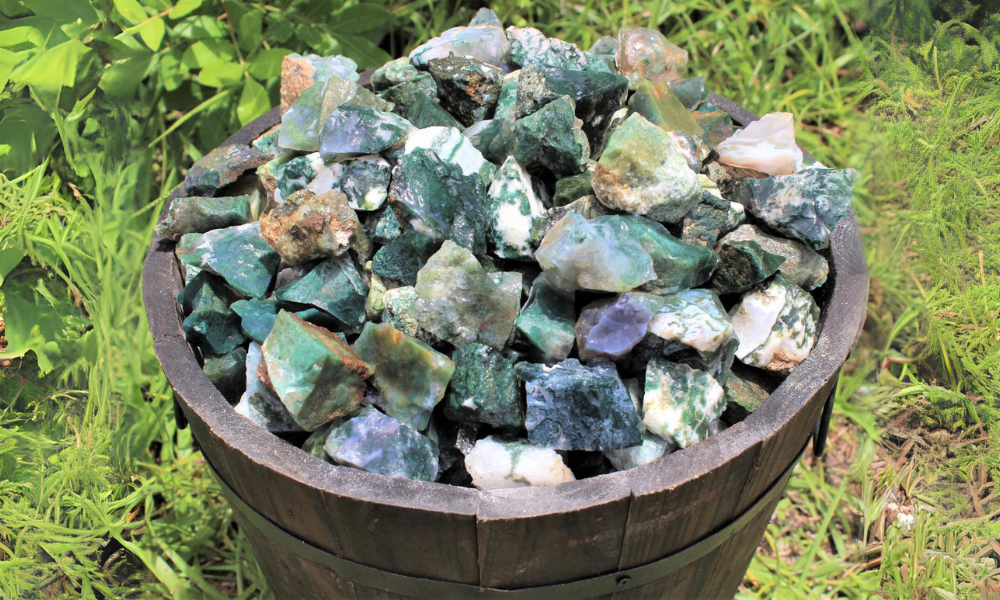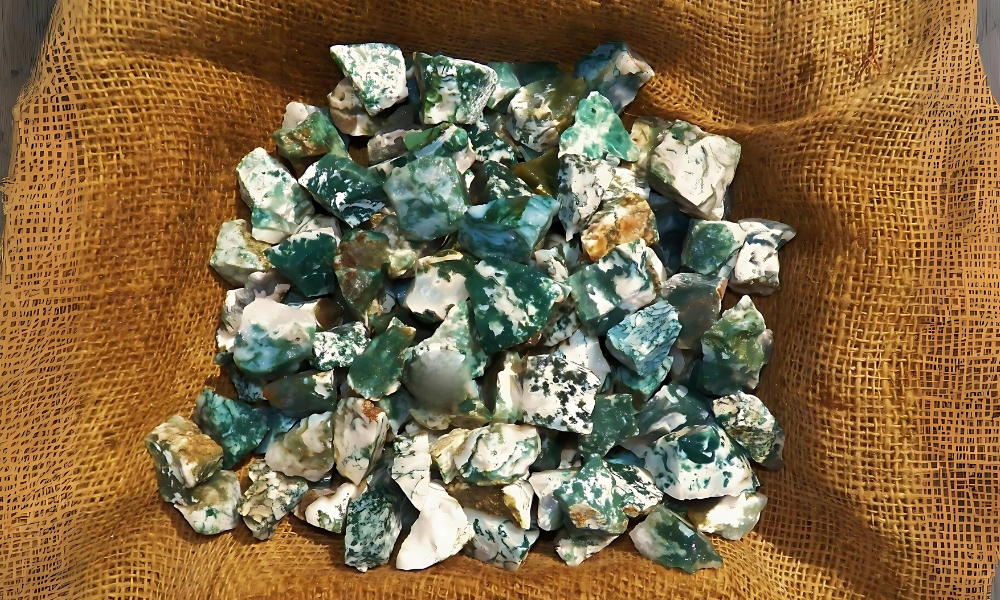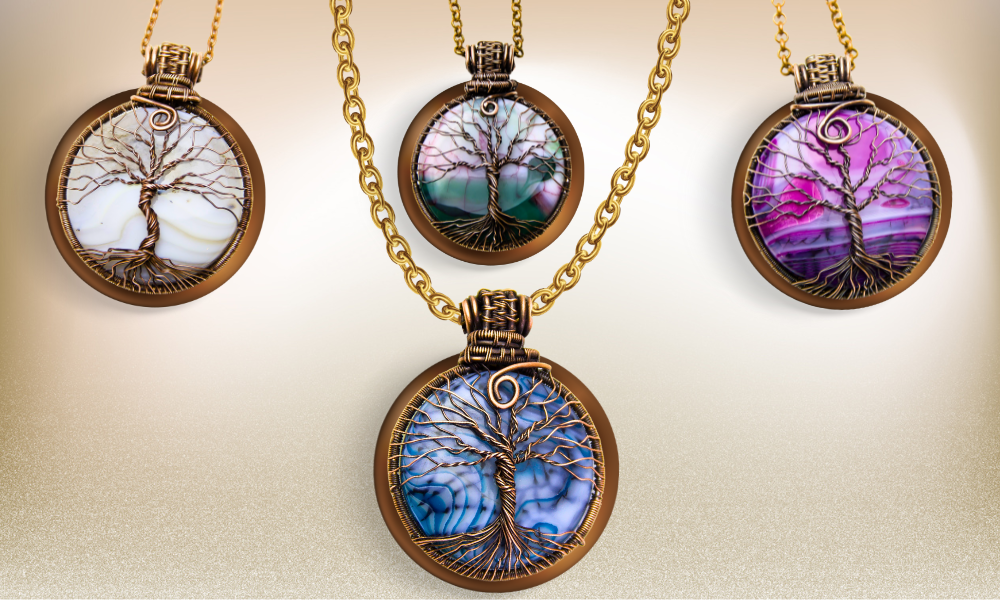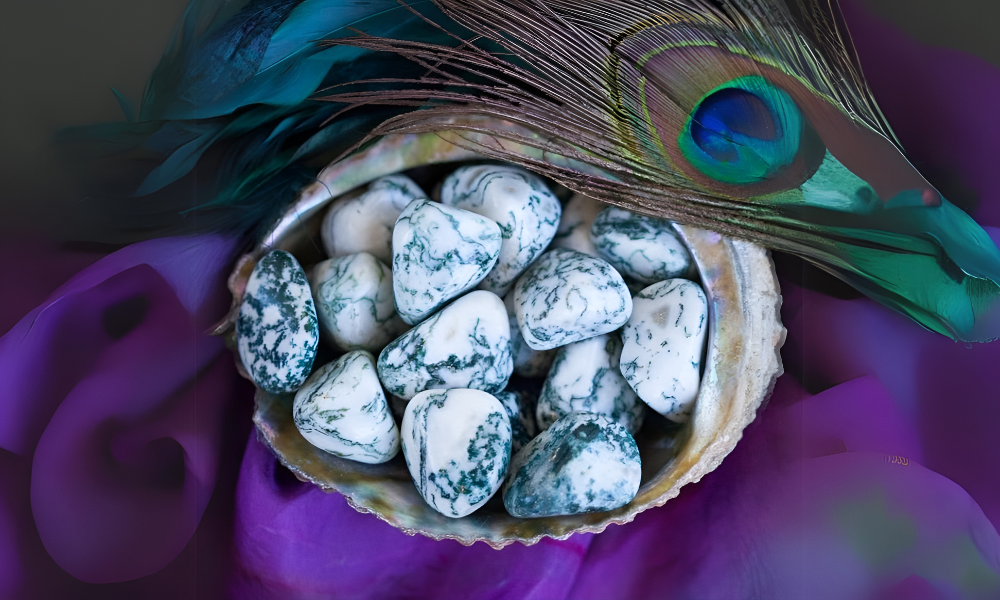Tree agate also referred to as dendritic agate or dendritic chalcedony is a beautiful form of chalcedony characterized by tree-like formations and pleasing colors. This semi-precious gemstone gets its name from the Greek words’ dendron’ which means tree since it has a dendritic or a tree-like appearance that resembles moss or fern patterns. These complex inlays are normally green in color, reaching from pale green to emerald, which really set against the paste milky white or cream ground similar to banded agate.
Tree agate is created by the slow growth of silica crystals in geologic locales with mineralized fluids. Over many layers of silica, purities such as manganese or iron, get trapped, syndromes the intricate dendritic growth that is observed in the crystal-like structure of the stone. These structures are regarded as representative of small-scale geography or biological forms; they infuse each article with a measure of natural grace and individuality.
No matter if it is prized for its beauty spirituality, or historical significance, tree agate will always remain a symbol of interest among gem lovers and other believers. The value transcends that of the beauty of the jewelry and the ornament; with history and meaning attached to its appeal.
Table of Contents
Geological Origins and Formation

Here’s a breakdown of its geological origins and formation:
Composition: Tree agate is mainly made up of a mineral called chalcedony which is a kind of quartz. Chalcedony itself occurs in cavities of volcanic rock; the depression or fracture could possibly be flooded by silica-rich fluids.
Formation Process
Volcanic Activity: The creation of tree agate starts with volcanism. The hot water which comprises mainly of SiO2 and other minerals seepages into cracks and crevices in the host rocks, which are mostly basaltic rock or other volcanic rocks during volcanic activity.
Silica Deposition: This they hypothesized happens over time as the silica-rich water cools down and starts to evaporate leaving layers of chalcedony inside the rock cavities. Because of the slow deposition rate, it is possible to form the different banding and patterns produced in dendritic or tree agate.
Dendritic Inclusions
Manganese and Iron Oxides: Some tree-like patterns in tree agate are dendritic in nature because manganese and iron oxides are used in the formation of tree agate known as dendritic tree agate. These oxides grow branched as the chalcedony precipitates around them.
Formation of Dendrites: Manganese and iron oxides deposit in a fern-like or tree-like structure because of chemical reactions with issued silica solutions. It’s typical for these dendrites to be brown or green while the rest of the chalcedony is white or grayish in color.
Geological Occurrence: Tree agate is nowadays encountered in different places of the earth where volcanic activity is observed. India is endowed with good deposits and so are Brazil, Australia, Madagascar, and the United States, specifically Oregon and Wyoming.
Thus, the physical characteristics of tree agate and their patterns can depend on the conditions of the geological formation of this semiprecious stone, the composition of the volcanic rock, and the character of the Silica solutions.
Appearance and Color Variations

Here are the key aspects of its appearance and the variations in color:
Color: Tree agate commonly has a clear to light gray base color if it has no overtones. This color creates the backdrop for which the dendritic patterns clearly stand out against. This is true in the sense that tree agate’s chief mineral element, chalcedony – which is a kind of quartz – exhibits a white or gray hue.
Dendritic Inclusions: One of the most outstanding characteristics of tree agate relates to its internal structures marked by dendritic or tree-like formation. These patterns are formed by inclusions of minerals for example manganese and iron oxides. A dendritic structure presents as a thin structure that is branching in nature with reference to the white chalcedony on the background. The dendrites can often be green or brown in color but can have any other color due to the minerals’ content.
Variations in Appearance:
Intensity of Dendrites: the features of the dendritic patterns can also differ greatly in terms of density and intensity between specimens a and b. There will be instances where the dendrites are little and spread only on a few areas or are thinly branched and can almost be seen as isolated particles and then there will be the dendrites that are thick and widespread and branching is widely manifested and covers large proportions of the stone.
Shape and Size: Shapes of dendrites also differ, they can be fine and feathery or broader and the way they branch. These variations are perhaps responsible for the kind of beauty that tree agate has and perhaps why every piece is different.
Translucency: Tree agate’s build and translucent effects can be influenced by the quality of the chalcedony and the degree of impurities within it. The translucency of the stone is also increased to allow the most light to pass through so that the dendritic pattern is easily observed.
Geographical Variations: Tree agate is discovered in various sites globally, and the characteristics of the geographical environment of certain sites determine the look of the stone. For instance, the tree agate stone from a certain area could have a slightly different tint or marks than the tree agate from another region owing to differences in the type of minerals or crystal growing process.
Historical Significance and Cultural Uses

Tree agate or dendritic agate has historical as well as cultural importance and has been used by different civilizations. Here are some notable aspects:
Historical Significance
Ancient Beliefs: In general, all kinds of agates have been appreciated for their alleged mystical and healing powers throughout history. Dendritic tree agate was one of the most common types of tree agate that depicted the form of trees and was often used for symbolizing rebirth, fertility, and abundance. Both ancient Egyptian and Roman cultures believed that agates could help a person be healthy, wealthy, and safe.
Decorative and Ornamental Use: Tree agate was known to be utilized as a decorative gemstone in ornamental jewelry and talisman or amulet items. The material was highly valued due to the elaborate and distinctive techniques in designing objects that not only had a pleasing aesthetic appearance but also a semaphoric one.
Cultural Uses
Spiritual and Healing Practices: Tree agate has Y in various cultures and is used to possess spiritual and healing features. This was applied to arrive at a fixed state within the society both physically and emotionally, majorly it was used in rituals and ceremonies. It was considered that due to the dendritic pattern designs, the wearer or user could be in touch with the forces of nature and draw its invigorating energy to him or herself.
Symbolism: The outlined shapes similar to trees or foliage stand for the soul’s desire to grow and develop as well as be in harmony with nature. In some cultures, people widely use tree agate believing that it will help them to renew the cycle of life.
Modern Uses
Jewelry and Crafts: Today, tree agate is still in demand in the production of jewelry and other artworks. Due to its organic pattern and religious connotations people find it very appealing and use it to design necklaces, bracelets, rings, and all kinds of accessories.
Decorative Objects: Besides ornaments, tree agate is applied in the manufacture of artwork: sculptures, souvenirs, and other merchandise. The natural-looking patterns and colors give it an added value to be used in interior decorating.
Collecting and Appreciation:
Gemstone Collectors: Tree agate is likely enjoyed by gemstone collectors and lovers for its look and the patterns that are dendritic. A preferred structure of dendrites is considered to be defined and detailed by collectors.
Metaphysical Properties and Healing Benefits

Tree agate being one of those gemstones is associated with metaphysical properties and has healing powers as per the New Age and holistic customs. Here are some of the commonly attributed metaphysical properties and healing benefits associated with tree agate:
Connection with Nature: Tree agate is linked often with nature and the natural environment due to the appearance of the tree or foliage kinds of patterns in the stone. Some people believe that it helps to establish interaction with these spirits, as well as the energy of the Earth, thus promoting gratitude and order.
Spiritual Growth: It is considered to have a positive effect on spiritual development and individual balance. Tree agate is associated with the energy of trees which signify growth and this specific stone if used is believed to enhance one’s luck in overcoming adversity.
Emotional Healing: Tree agate is reported to have a calming effect that will reduce tension, anxiety, and even fear. It is said to help stabilize emotions and to help one feel relaxed so that one can look at life as being full of the positives.
Physical Healing: As for the physical curing aspect tree agate is believed to possess characteristics that can strengthen the immune system and bodily energy. It was reported to have the ability to ease sickness signs and symptoms and enhance body health.
Balance and Grounding: It is a stone that is used to help balance the energetical fields of a person as well as balance his/her emotions. Some people attribute this particular meaning because it tends to introduce the concept of order and balance into the lives of its users and, therefore, it is helpful when one wants to feel anchored in change.
Manifestation and Abundance: Today, some people accept tree agate to improve the effectiveness of the manifestation of desires and attraction of wealth. The action is believed to adjust the individual’s energies with the spiritual similar to trees, meaning riches in nature.
Chakra Alignment: Concerning therapeutic corridors of chakra energy, tree agate is connected with heart chakra or Anahata. It is said to purify and stimulate the heart chakra thus helping in issues to do with emotions, forgiveness, and love.
Mental Clarity: It is assumed to free the mind get rid of undesirable thoughts and influence the thinking of a particular person. Tree agate also helps to sharpen focus and concentration, thus improving the capabilities for decision-making and problem-solving.
Uses in Jewelry and Decorative Arts

Tree agate is reputed for its pattern and its mystic power, which makes it a popular ornament and décor material. Here are the primary uses of tree agate in these contexts:
Jewelry
Pendants and Necklaces: They are mostly incorporated into beads and amulets as tree agate is often used to make pendants and necklaces. The material’s dendritic patterns and pale colors also make them ideal for items that are meant to instill tranquility and a sense of unity with the environment.
Bracelets: Another type of tree agate jewelry or accessory manufacture includes bracelets crafted from beads or cabochons of tree agate is believed to have metaphysical attributes and is also worn for its looks. They are worn for beauty purposes as well as for therapy believed to be contained in the beads.
Rings: Although not very frequent as it is not as hard as other gems, tree agate is sometimes incorporated into rings. It’s often placed in protective conditions to avoid suffering more damage to the stone.
Decorative Arts
Carvings and Sculptures: Tree agate can be easily carved into figures, animals, or virtually any figure or shape because of its natural patterns and derived colors. Such items are prized for their aesthetic and perceived occult characteristics more than they are for artistic merit.
Ornamental Objects: Tree agate is employed in the carving of required items including ornamental objects and arts like paperweights, book ends, and fancy bowls. This gives it a natural look that makes it blend well with interior decorations.
Mixed Media and Artisan Crafts
Mixed Media Jewelry: Tree agate is commonly sold along with other gemstones, metals, or any other material in mixed-media necklaces. This makes it possible for artisans to be able to develop new and distinguishing patterns that will bring the best out of the agate.
Wire Wrapping and Beading: In the field of artisan crafts tree agate is used in particular in techniques of wire work, or included in woven bead designs. This flexibility opens up a variety of opportunities in which unique jewels that meet the customer’s wants can be designed and manufactured.
Collector’s Items: Tree agate is seen as a rare object of collection and also for its dendritic, pattern. Individuals favor samples with good dendrites or with abnormal color or hue because the specimens are collector’s items.
Caring for Tree Agate

Caring for Tree Agate, like other gemstones, involves a few simple steps to keep it looking its best:
Cleaning: Tree agate stones can be washed with warm water soap and brush which should be soft. Refrain from using acidic products, or those products that could potentially strain or harm the stone or the material that it has been applied.
Storage: Tree Agate should be stored separately from other gemstones in order not to be scratched. That is why it is recommended to store it in a soft cloth pouch or in a lined jewelry box.
Avoiding Damage: Tree Agate is not that hard and can be scratched by other harder materials although it is not that brittle. Do not wear it during any activities that it could rub against rough surfaces.
Recharging: To cleanse Tree Agate, it is taken under running water for a few minutes or left in the sunshine or moonlight for a few hours.
Handling: While using Tree Agate do not grip it by the pointed edges or corners as this is easily broken. Now that you know how to properly take care of Agate here are some simple care tips that will help keep your Agate looking gorgeous and intact forever!
FAQs about Tree Agate
Q1. What is tree agate crystal good for?
This kind of gem assists persons in searching within for reflection of their inner selves, and this likewise may likely cause a peaceful carriage. As for agate in general, it is believed that the stone is associated with stability in one’s life, making tree agate a more intensified type. Another acknowledged ability of the agate is its capability to improve immunity and regulate water metabolism.
Q2. Is tree agate worth anything?
It is rather peculiar when compared to most other gemstones; however, it may not be as costly as one might expect. The majority of agates do not cost a lot of money, only ranging from $1 to $20, yet some agates can reach up to a considerably higher value depending on the type. Again, this ranges between hundreds, if not thousands of dollars depending on the surgeon.
Q3. How is tree agate made?
Most Agates are found in the form of nodules in volcanic rocks or old lavas whereby they are structures left behind after volatiles that were present in the mass released the gases and left behind cavities altogether or simply filled them with siliceous materials and as these materials spread uniformly on the walls and deposited by layers from which the crystals grow.
Q4. What are the benefits of agate?
It is believed that agate strengthens blood vessels and maintains normal blood flow throughout the body. This stone’s soothing aura and reassuring presence guarantee that you will sleep well and comfortably. This stone will boost your immunity and metabolism, keeping you healthy.
Q5. Who can wear tree agate?
People with high blood pressure are advised to wear agate jewelry as it can assist in balancing their blood pressure. This stone does wonders for boosting immunity. It’s a stone that represents calmness and harmony. Wearing jewelry made of agate will make you feel powerful and capable.
Stay Tuned to Gems Tycoon for all gems-related articles.









